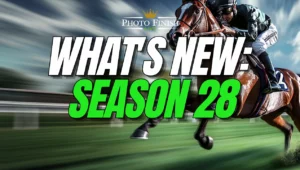Managers, it’s finally time for Part 3 of the ticket match article. This is your Lead Designer, Paul N, here to analyze the effects of matches on V.1 Gen 1+ and explain a change that we’ve made for V.2.
This article was largely written before the change that briefly occurred in the last article, and has nothing to do with the S+ horses. Because of this, I’m adding a section at the end to talk about them. You can skip right to “What’s Going to Happen to the S+ Horses?” if you want to miss something important
How did trait matches affect V.1 future generations?
Understanding the specific effects of matches on future generations is harder than Gen 0. We can’t take a real Gen 1 and “remove its matches” because matches, themselves, aren’t genetic (They produce good genes). What we CAN do is pick a pair of Gen 0s and compare the average values of their foal with and without matches in the parents. Before we do that though, let’s recap how breeding works.
When a foal is born, 50% of the Stud’s genes and 50% of the Mare’s genes get combined together to create the foal’s genes. Every single match improved the total value of your genes. If you would have been a 1-1-1-2-1, the match made you a 1-1-1-3-1 or a 2-1-1-2-1 or some other improvement of that nature. The improvement was relatively small in attributes and relatively large in preferences. Each match improved something and often improved multiple things. Every single match you made also improved your total Bonus Count, a number which translated into better quality genes. This means more 2s and 0s than 1s.
Now let’s look at some horses. I’m using horses with two and three matches each, in order to get a result somewhere in the middle of the range of effects. I’m going to refer to them as Stud and Mare.
Stud is an A- horse with 3 matches. Their stats are:
- Start: A-
- Speed: A
- Stamina: A-
- Finish: A
- Heart: A-
- Temper: A
- Direction: 3 Star
- Surface: 2.5 Star
- Condition: 3 Star
Mare is an A horse with 2 matches. Their stats are:
- Start: A-
- Speed: A+
- Stamina: A
- Finish: A
- Heart: A+
- Temper: A+
- Direction: 3 Star
- Surface: 2.5 Star
- Condition: 2.5 Star
With matches, the average foal looks like this:
- Start: A-
- Speed: A
- Stamina: A
- Finish: A
- Heart: A
- Temper: A
- Direction: 3 Star
- Surface: 2.5 Star
- Condition: 2.5 Star
Without matches we get this:
- Start: A-
- Speed: A
- Stamina: A
- Finish: A
- Heart: A
- Temper: A-
- Direction: 2.5 Star
- Surface: 2 Star
- Condition: 1.5 Star
What isn’t obvious here is that the attributes (not prefs) without their matches lost allele quality (Fewer mins and maxes, more average numbers). While the best high variants outcome for each horse was virtually the same, the average number of high variant alleles dropped in the unmatched foal. While that does make for consistency in future generations, the best possible outcomes of those future generations were, on average, lower.
Did We Meet Our Promised Match Design in Future Generations?
“The better genes that came from the better tickets that came from matches WILL likely produce better foals” – Paul
“A 5/5 or 4/5 would be much more likely to have a stronger genetic profile (which would play out in our system as a much higher likelihood to pass on those strengths to future offspring” – Ian
The honest answer is, “Kinda?.”
We’re not happy with it. Matches gave 1 boost in a stat and 1 (or more) boost(s) to Temper. Each boost guaranteed an improvement to the quality and total value of your genes. Those improvements guaranteed that the selection of your foal’s genes came from a better pool of possible options.
That being said, it really does not feel like, “A much higher likelihood to pass on those strengths to future offspring.” Because you didn’t need a match to get full boost, (and hence full benefit), there wasn’t anything special or unique about the matches that players chased down.
Because of this, we’re testing a change in Beta V.2.
How Do Trait Matches Work in Beta V.2?
This has been a long set of articles so let me first reassure you that the change is pretty simple. I mentioned earlier that boost count makes sure that a certain portion of your attribute comes out in high variant genes. We’re going to have Match Count work in a similar way.
Previously: Each boost in a stat increased the minimum number of high variant results for that stat.
New: Each boost in a stat still increases the minimum number of high variant results for that stat. Additionally, each match on the ticket gives a much smaller increase to all 6 stats.
Boost still provides most of the benefit for each individual attribute. However, we’ve upped the maximum possible quality value so that matches can also provide a benefit. While their value to one stat is much smaller than a boost, the sum of their value to all stats is similar. By making this change, matches have a specific and exclusive benefit for “passing on (their) strengths to future offspring.”
And remember, every horse still has an opportunity to come out with maximum allele variants. We’ve just made sure that if you worked hard to find matches, you have a bit of a better shot.
Thank you all for following along through this hefty set of articles. I know there will be many questions. A lot of specifics had to stay under wraps to protect the system, but I hope the explanation was thorough and the match change seems fair.
Until Next Time,
Paul
P.S. – What’s Going to Happen to the S+ Horses?
I’m going to start with a quote from the big man himself, “Seriously, the 2 1/1 perfect matches broke all formulas… A theoretical maximum… that is beyond any measure of rarity calculations. We purposely nerfed them so that they wouldn’t leave literally every single horse behind.” – Ian.
While it’s not quite how I’d say it the point remains true. The 1/1 horses didn’t fit anywhere close to the scale of the rest of the PFPs. We nerfed them with the intent to make them fit the system.
However, data from V.1. shows that the S+ horses were significantly poorer racers than the S group. Considering that these horses came from the rarest and most expensive PFPs in the game, the nerf went too far. The change we made was an arbitrary change and we made it at a very different point in the race math development. Now that the race math is more solidified and we’ve seen how these horses played out, we need to update that choice.
More than one player has attempted to identify the match algorithm in the breeding tool (We also made it pretty clear in this article series). Each match earned you 1 boost in an attribute and one boost in Temper (up to 3). Each match also earned some amount of preference (based on which boosts you ended up with).
When we reigned in the S+ horses, we didn’t run them through the match rules, we gave them fixed values. While there are a few options for what we could change, one seems clearer and fairer than most: Update the horses, fairly, through the match algorithm.
Two horses managed the unbelievable effort of successfully matching up 1/1 PFPs and those two horses will be updated following the match algorithm. The result will be horses with Attributes: {1, 1, 1, 1, 1, 3} and Preferences: {1, 1, 2}. At the end of the day, these were stats they had earned, and they should have had them. Technically the other two will “run through the algorithm,” but seeing as they are unmatched, they’ll stay as they are.
While plenty of ideas have surfaced for how to tackle this, at the end of the day, this one seemed correct because it follows a rule that all the other tickets had to respect. Data from V.1. supports that our change wasn’t optimal. Let’s see how this one feels.





